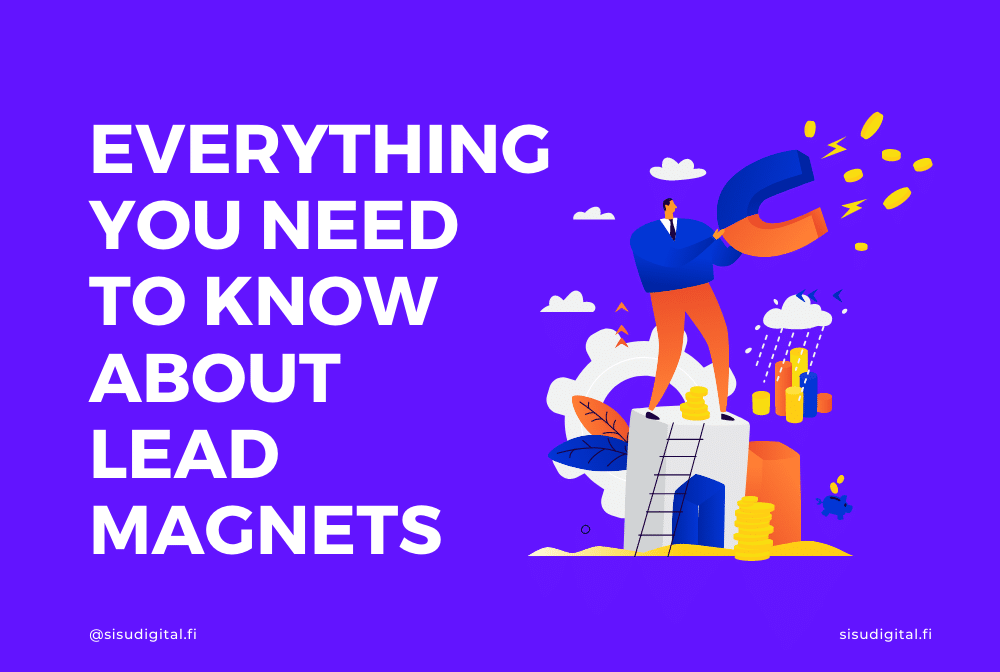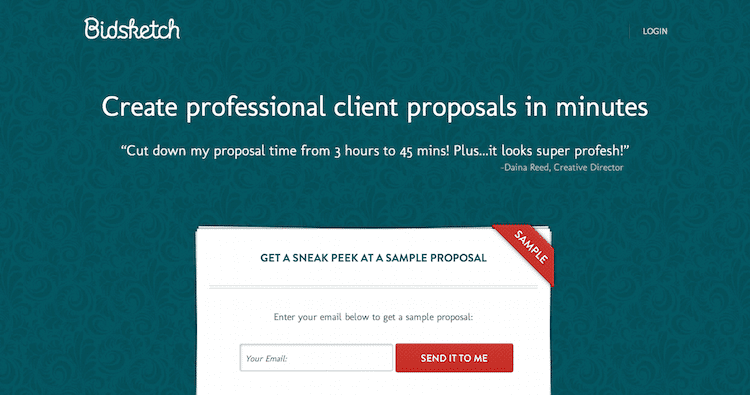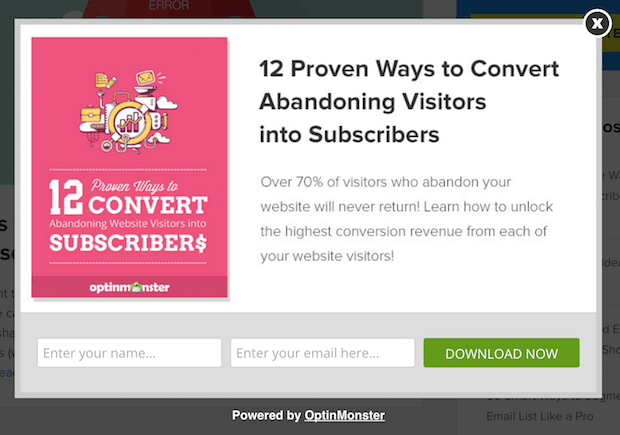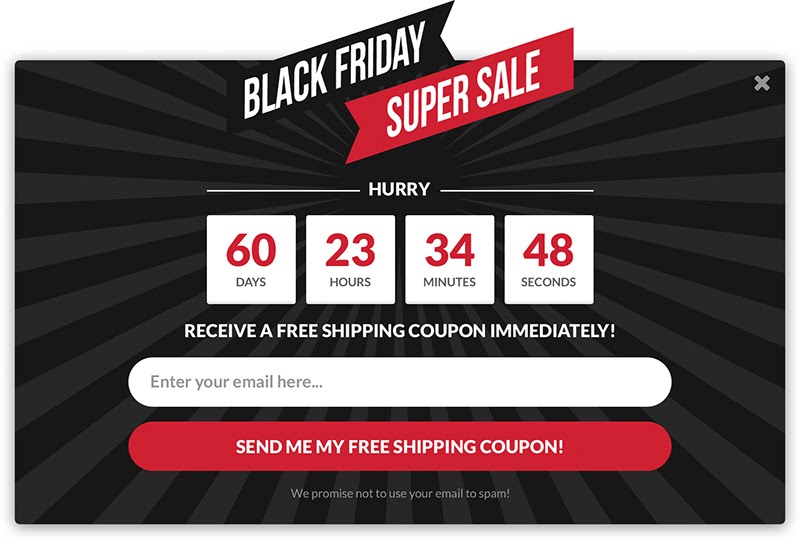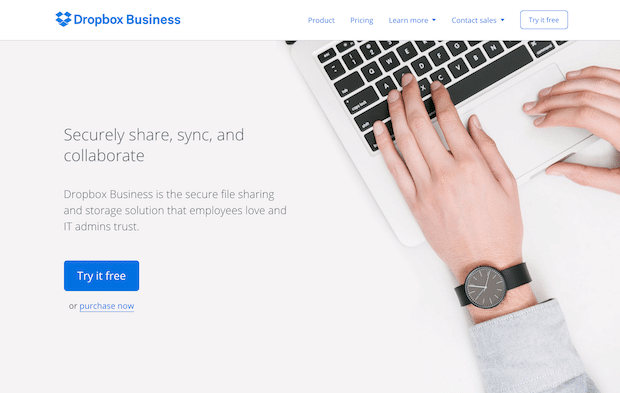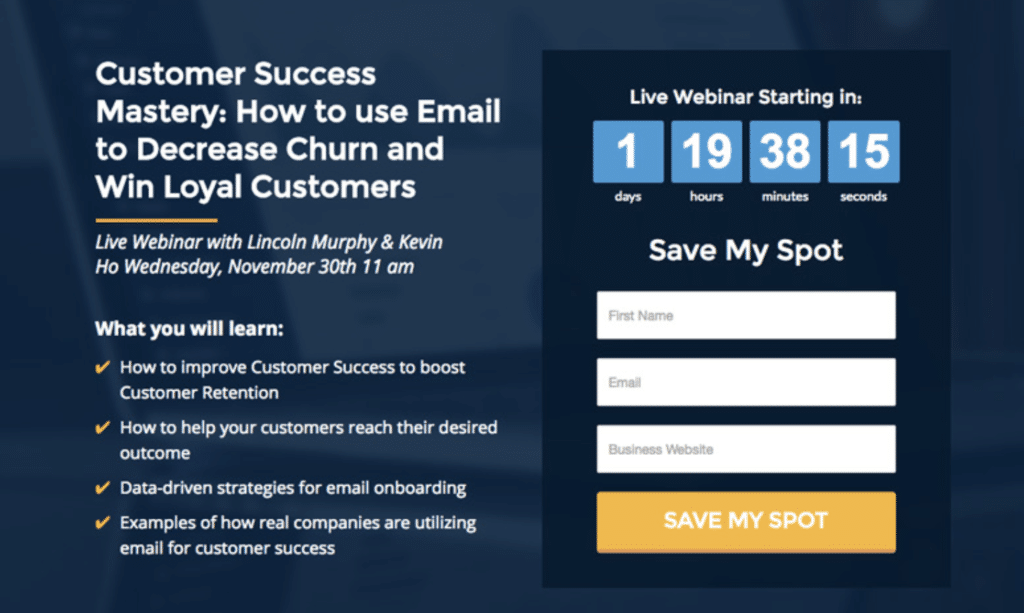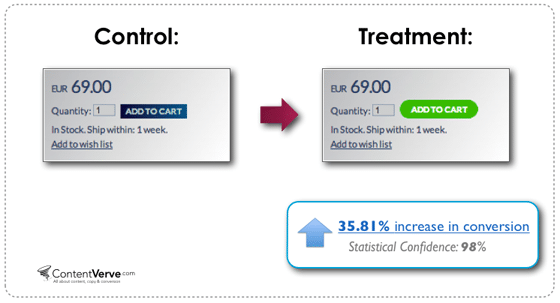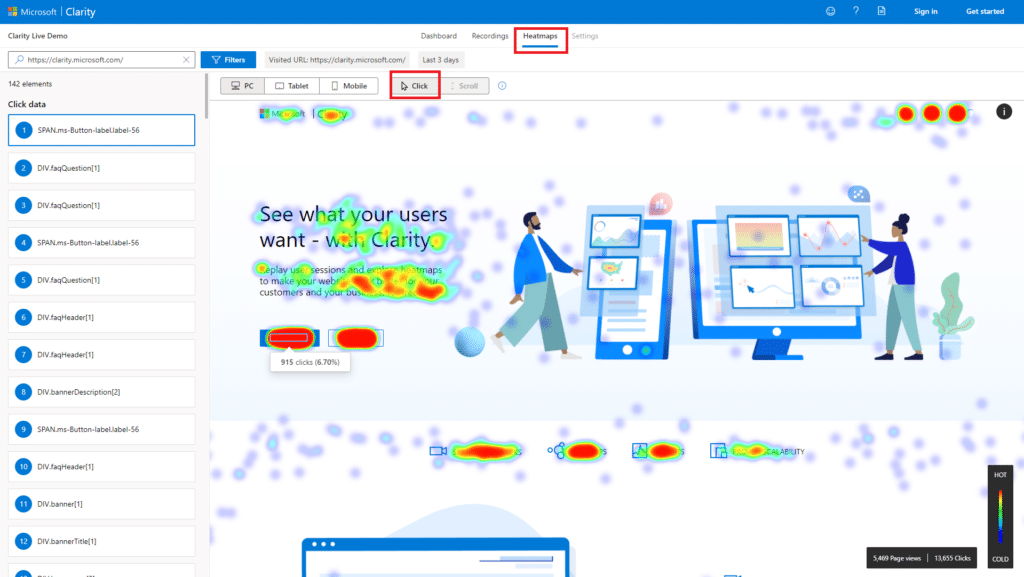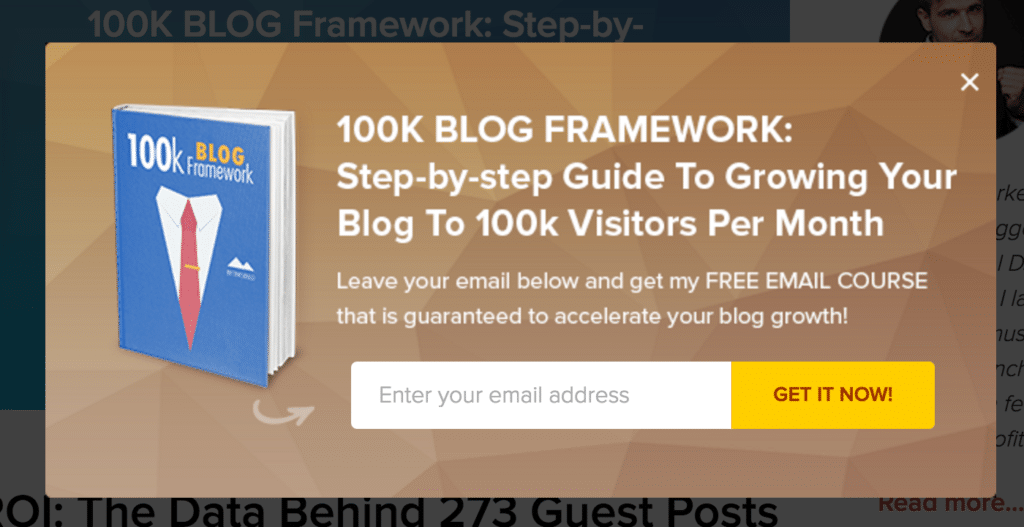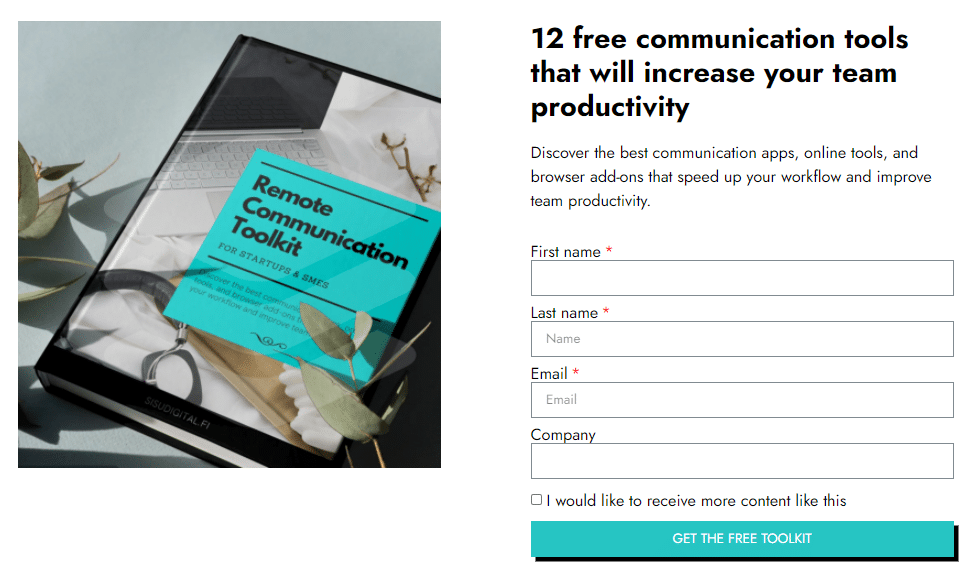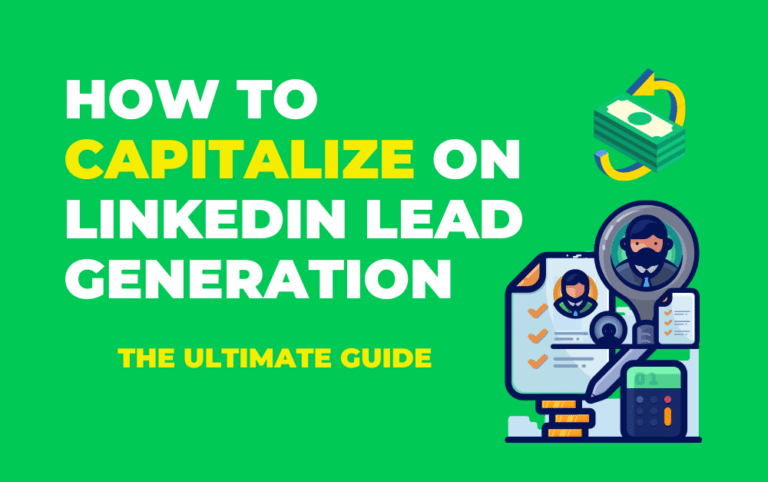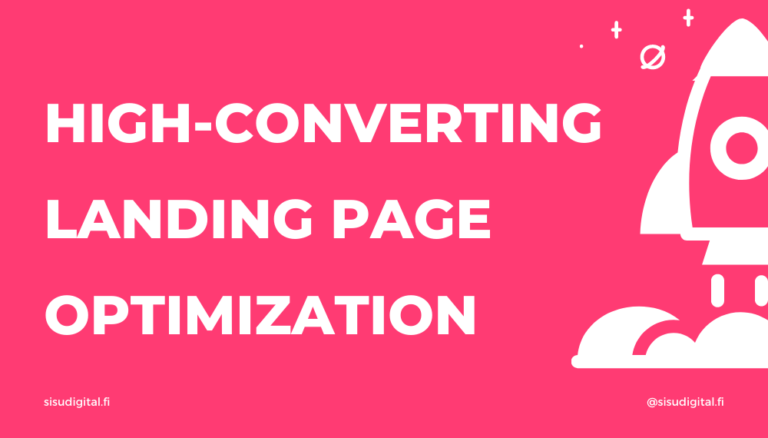People are not willing to share their contact information unless they have something to gain from it. That’s where lead magnets come in. Lead magnets are proven to increase the conversion rate for your lead generation activities.
They do not, however, guarantee sales, because this also depends on the type of lead magnet that you make and which stage of the buying journey your prospects are.
The purpose of a lead magnet is to gain contact, grow your email list, educate and nurture your prospects. So that when they are ready to buy, your business will be the number one choice.
1. What is a lead magnet?
A lead magnet is a special offer that you give for free in exchange for contact information. By using lead magnets, companies gain valuable information from potential customers such as their name, email address, title, company, industry, and other useful information. The form that asks for these details acts as the gate that filters people who come across your content.
Lead magnets are not the best tool if you want to build brand awareness because you’re limiting viewership from people who aren’t comfortable with sharing their information. But they’re perfect for lead generation because of the contact you gather.
Anything can become a lead magnet if they provide enough value. There are different types of lead magnets such as downloadable content, free consultation, product demo, and even entertaining lead magnets.
Downloadable content: content upgrade, pdf version of your blogs, ebook, guidebook, template, checklist, toolkit, resource list, cheat sheet, calendar, printable, infographic, case studies, industry report, free recording of an event, etc.
Free consultation: free coaching session, webinar, free quotes, etc.
Product demo: app download, free trial, limited premium membership, free text/audio samples, product tutorial, etc.
Entertainment: quiz, challenge, survey, giveaway, coupons, etc.
As the market becomes saturated with many lead magnets vying for people’s information, marketers have to find a way to innovate. Don’t limit yourself to the typical lead magnet, you only need one that showcases the value that your product or services offers and captures customer’s attention.
2. Identify your lead magnet’s value proposition
2.1 Customer persona
Before thinking about what type of lead magnet is good for your business, you need to know who you’re making it for. The best way to start is with your customer. Even when you have B2B clients, you’re still selling to humans with motivations and needs of their own.
Your customer is not simply a tech start-up with 10 employees. There are decision makers, influencers, and other stakeholders surrounding that tech start-up. Who is it that you are selling to?
Dig a little deeper and try to understand what is it that your prospects want to accomplish and what’s stopping them from doing so. Only when you have that knowledge can you truly know what value your lead magnet can offer.
That’s where the buyer persona comes in handy. It is the representation of a customer group that shares a common value, needs and bottlenecks. These are the information that a customer persona should have:
- Age
- Gender
- Job
- Value
- Needs
- Goals and motivations
- Bottlenecks
- Behavioral patterns
2.2 Value proposition
Be very specific about what you’re offering: what problems are you solving and how are you solving them.
One quick win: problems are usually complex and can’t be solved with just one piece of content. They require multiple steps of actions, constant intake of new knowledge, and support from different tools to be solved. If your lead magnet tries to solve all of these problems at once, it can easily confuse readers with too much information.
Make it easy to consume. Sometimes, a small win is enough. This way, you can also offer a variety of lead magnets, build trust, and help your prospects move to the next stages of the customer journey.
Solve one important problem: the important problem is the one that people are willing to spend money on. Look to your competitors to see what they’re offering, shadow communities, or marketplaces where your prospects spend their time and money on. You’ll soon find out what people are talking about and what resonates with their needs.
Timely content: when something is on-trend, you better catch it. For example, Single’s Day hasn’t always been celebrated worldwide. But after Alibaba’s sales top $74.1B, many international retailers want to jump on the bandwagon. Why not try a lead magnet analyzing this success and sharing strategy for Single’s Day next year? Coupons are also a good lead magnet for these occasions.
3. Designing your lead magnet
3.1 What kind of lead magnet is good for your business?
The answer is: depends on your customers and where they are in the customer journey. Different stages of the customer’s lifecycle call for different types of lead magnets.
Awareness: in this stage, most companies wouldn’t want a gate on their content because it limits viewership. However, using a lead magnet can help filter your viewers, which lets you know precisely what kind of target audience you have.
Educational lead magnets such as podcasts, infographics, and whitepapers enable companies to recognize their problems and build credibility for their brand.
Consideration: prospects begin to acknowledge your brand authority and consider your products to be the solutions to their problems. They will also talk to your competitors and make comparisons.
Lead magnets that provide more information such as webinars or case studies are useful for introducing your product to potential customers. These types of content let your brand talk to prospects, understand their needs, and explain more about your product or service.
Decision: lead magnets that instigate actions such as free consultation, free trials, and product demos are powerful for the purpose of pushing your prospect to the finishing line of their buying journey.
Once you know which stage your prospects are in the customer journey, it’s time to think about how you can present your solutions.
Leverage your strengths: if you’re good at speaking, make a video or host a webinar. If you’re more confident with graphic design, convey your message through visuals instead. Your lead magnet doesn’t always have to be textual.
3.2 CTA
For lead magnets, button CTAs have proven to be more effective than link CTAs.
Make it bold and distinctive.
Take Dropbox here as an example. The margins around the button are spacious enough that it doesn’t confuse your eyes. The button is blue on top of a white background, accompanied by a small amount of black text, so instinctively, you know where to look. Your CTA should grab viewers’ attention right away.
For prospects that are at the end of their buying journey, you’d want to have a CTA that triggers a sense of urgency or fear of missing out. For example, include in your CTA a time-sensitive discount or limited offer.
Learn how to write better marketing copy and CTAs with our copywriting techniques: how to create powerful marketing copy
A/B test your CTA buttons: Try different color combinations, shapes, phrases, or the positions of your CTAs. For example, from testing their CTAs, ContentVerse learned that a rounded box converts better than a square box. If you’re not an experienced A/B tester, test only one variable at a time. In that way, you know which variable affects the conversion rate.
Use heat map: Along with A/B testing, use a heat map to identify which areas of the website do viewers linger, their activities, and click patterns. Once you have this knowledge, place your lead magnet in the “hot” places of your website. For this purpose, you can try Microsoft Clarity.
Using exit pop-up: one of the best ways to display your lead magnet is actually by using exit pop-up. It works even better when the lead magnet is highly relevant to the blog. You could set it up so that the lead magnet is like part 2 of your blog – a more advanced piece of content that if viewers want to keep learning, they can download. Or it could also be added-value content such as a checklist or template that was relevant to your blog.
3.3 Design
Content is king. But no matter how good your content is, messy design can make your readers lose interest. In fact, if your lead magnet has an attractive cover, it might receive more downloads or registrations.
For text-focused lead magnets such as ebook, guidebook, or pdf version of a blog, it might not be necessary to have a fancy design. But for visual lead magnets such as templates, and infographics, you’d need a suitable way to present them. It also depends on your brand, if your company is a design house, then it’s absolutely recommended that the visual of your magnet stays on brand.
Two free tools that we can recommend for you are Canva and Smartmockup
Canva – Jazz up your content
While the platform lacks comprehensive and advanced features for design, it offers a large collection of templates, icons, and stock photos. Canva is simple and easy to use. It is the perfect tool for design beginners to practice visual literacy or busy solo entrepreneurs that just want to get their products out there.
Smartmockups – Create a cover for your lead magnet
If Canva is used to jazz up your content, then Smartmockups, as the name suggests, create mockups for you. You’ve seen a lead magnet that was designed to look like a book right, even though the content inside is a tool list or an industry report. By our guess, this probably helps to increase the credibility of your lead magnet because books have always been regarded as a trustworthy source of information.
4. Delivering your lead magnet
The fundamental steps of delivering your lead magnet include:
- Landing page
- Thank you page
- Lead magnet sent to email / Welcome email
- Follow up emails to nurture your contact
4.1 Landing page/ Form
The basic structure of a landing page goes like this: a short introduction about the lead magnet and the form. Some companies also include a table of contents to give a sneak peek at what people are about to download. Some go further and include an about us section for their companies.
Regardless of what you put on your landing page, your form is the most important element. Forms help you gain information about your leads. The basic forms usually ask for information such as name, email address, and company.
The more you ask, the more you learn about your customers. But this comes with a risk and should only be done when you know that your content is valuable enough.
Do you need a landing page for your upcoming product launches? Sisu Digital offers web design services for landing pages, one-page websites, and multiple-page websites.
Not seeing what’s right for your company? We also develop websites customized to your business needs.
Customize your form based on your website visitors and their characteristics. We can’t specifically recommend the customizations because we don’t know what kind of tools you use to create landing pages, but we can suggest:
- Pre-populate form fields for repeating visitors – avoid repetitive form-filling
- Dynamic forms depending on devices, locations, and lifecycle stages – maximize the user experience of your website visitors and learn new things about them
- Web personalization – show each visitor the content and message that is right for them
Setting up your forms is more than deciding what information to ask. It’s also about the automation that happens after your website visitors have filled in the form. For example, do you want to redirect them to a thank you page, or send their contact information to a database?
It’s important to think about how you want to follow up with your prospects after they have received your content.
4.2 Set up a marketing automation campaign
After you’ve launched your lead magnet campaign and contacts start streaming in, it can get hectic. That’s why you need to imagine the journey that they will take after receiving your content before you launch the campaign.
These are the things that you need to think about:
- Where will your contact go? (where do you store your database, or if you use a marketing automation tool, which list will they be added to)
- What do you want to do with these contacts? (engage them in a lead-nurturing automation, send a sales rep to follow up?)
- What kind of content would they like to receive to keep your company relevant?
- What kind of follow up emails will you send? How many will you send?
If you use an advanced marketing automation tool like ActiveCampaign or Hubspot, there are millions of automation that you can do. But the best thing to do is to keep it simple. The more complex your system is, the more likely you are to mess up.
Always test your automation before activating it.
For Sisu Digital, we have kept our lead-nurturing campaign quite straightforward.
- First, we sent them a thank you email along with the lead magnet they requested
- Two days later, we introduce them to another lead magnet or free resources that we have at our disposal
- Two days after that, we send them some of our blog posts that we think are helpful and relevant for them
- In the last two days of the campaign, we ask them to join our newsletter. If they don’t or there’s no response, we stop sending them emails.
- When they join our newsletter, the automation sets off and automatically adds them to our email list.
- After this, our subscribers are enrolled in an RSS feed campaign which notifies them whenever a new blog post is added on a weekly basis.
You’d want to time your email automation efficiently. Don’t send your prospects too many emails within a short period of time because it’s spammy and causes annoyance. Don’t take too long either because you’d want to keep engaging with them while they still remember you.
4.3 Promotion
Content marketing is 20% content and 80% marketing. Your content is a gold mine, not taking any actions to promote it is a waste of good content.
Identifying your audience, competitors, and value proposition are not only for designing your lead magnet but also to ensure that it gets to the right person. Once you know where your target audience frequents, you know which channels you need to focus on, in terms of effort, time, and budget.
The organic ways of distributing your lead magnet are:
- Social media channels – post it on your company’s page, personal page, and encourage your employees to share it on their channels as well.
- Add it to your email signature, author bio, LinkedIn profile, and other social profiles.
- Content upgrade of a blog post – find a high-performing blog post that’s relevant and attach your lead magnet as a pop-up.
- Offer it as a freebie in suitable Facebook and LinkedIn groups – find active groups that have a lot of your target audience.
- Promote it to your email list/subscribers.
- Offer it as a gift to your audience during your speaking engagements
- Different places in your website – sidebar, footer, exit pop-up, resource page, etc.
- Whenever possible, link your lead magnet throughout content like blog posts or other lead magnets.
At the same time, you can promote your lead magnet non-organically
- Cold email outreach
- Social media ads
- LinkedIn ads
- LinkedIn outreach
- Google ads
5. Conversion tracking
After spreading your lead magnet all over the internet, do you know how to keep track of the massive traffic that you will receive?
Google Analytics by itself doesn’t always attribute traffic sources and mediums correctly, that’s where UTM Parameters come in.
UTM parameters are special codes that are added to your URL to track website traffic from its origins. There are 5 things that UTM codes can track:
Source: which website is sending traffic to you – Facebook, LinkedIn, and any other websites that you share your lead magnet.
Example: utm_source=Google
Medium: how that traffic gets to your website – post, ppc, email, etc.
Example: utm_medium=email
Campaign name: track promotion links that were placed as part of one campaign
Example: utm_campaign=valentinesday
Content: track links that come from the same source or medium. For example, this can be used to differentiate two different types of ads that run on LinkedIn, or two links that are on the same page, such as the sidebar or the footer link.
Examples: utm_content=textads or utm_content=sponsoredcontent
Term: track keywords that you have paid for.
Example: utm_term=web+design+agency
Here’s how you can set it up.
Best practices:
- Document your UTM codes into a spreadsheet to easily organize and keep track of them.
- Create a naming convention so that your UTM codes are consistent for conversion tracking. For example, you could generate a duplicate if you don’t specify the use of lower case or upper case for a piece of code.
- UTM codes are visible to your audience, so don’t use any codes that you don’t want them to see. After that, shorten the links with bit.ly so that it’s more presentable for sharing. Because links that are too long can seem spammy and unprofessional.
6. Make your own lead magnet
We’ve shared our knowledge on how to make an effective lead magnet, are you ready to make yours? The process we’ve shown might look intimidating but it’s easier once you get started step by step.
Keep in mind that it might take a whole month to get your lead magnet up and running, so give yourself and your team some buffer time to learn and apply their knowledge.
Don’t have enough time or manpower to get things done? Why not let Sisu Digital help you set it up? We provide digital solutions that help your business grow and get more customers.
Subscribe to Sisu Digital for more lead magnet tips, digital marketing knowledge, and business insights.
